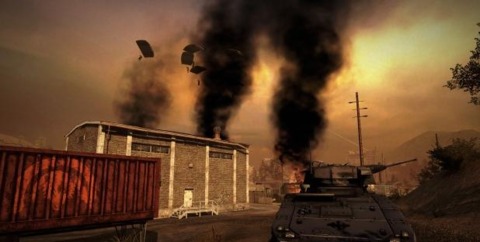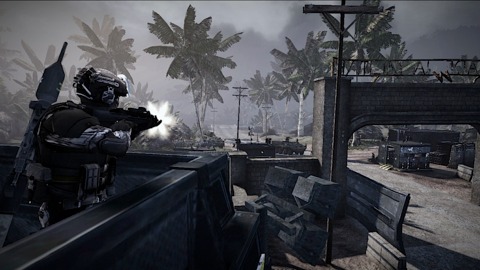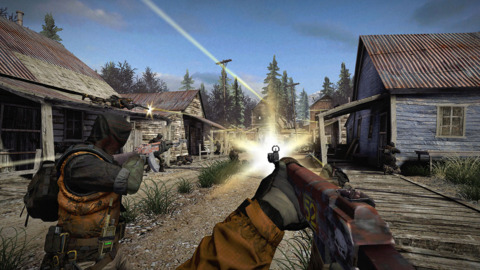
It's plastered all over the box, but it's worth repeating to make sure your expectations are set properly: MAG is a multiplayer-only shooter. Short of a brief and largely ineffective training session that shows you how to crouch and throw grenades, every other aspect of MAG puts you into battle against other human players. It all starts by forcing you to choose one of the game's three factions. In the end, the three factions are fairly interchangeable, but the game makes this decision seem like a huge deal. Once you've created a character and joined a faction, you'll have to reach the game's level cap to change sides. There's only one character slot, too, so if you want to try all three sides, you'll have to either create more PlayStation Network accounts or erase your existing character and start over. It's a good way to force you to feel some loyalty for your faction, but like most other things in MAG, the game doesn't give you enough information up front to feel like you're making a well-researched and reasoned decision.
Once you've selected a faction and moved forward, you're given a set of preset weapon and equipment loadouts and offered the game's simplest game type, suppression. This is a team deathmatch game for up to 64 players, and unlike the other modes, it's an in-faction match that pits members of the same faction against each other in what the universe justifies as a training exercise. With none of the objective elements and leadership bonuses that make MAG more strategic and only one map per faction, suppression matches are only useful for getting players used to the way MAG's guns feel.
The other three match types increase the complexity and get more interesting. Sabotage is another 64-player match, and it's a basic control point battle with one team attacking and the other on defense. Even in this "small" match, things are broken up in a way that makes the game feel smaller than it is, as different squads are sent to different control points. The end, however, culminates in the full attacking team moving on a final control point. When you see 32 guys all trying to run into a tiny area and plant explosives, you finally get the full effect of MAG's scope. Weirdly enough, this 64-player match is really the only match that bunches players together like this, and it ends up feeling more chaotic and crazy than strategic and fun.

Domination is the only mode where you'll get a full 256 players in game. It offers the largest command structure and the most objectives, but it rarely feels more populated than sabotage games. While you'll have 128 players on a team, the size of the map means that the different squads are spread around the battle, attacking or defending different positions. So even though the game will look different to players in leadership positions, the actual action doesn't feel much different than the control point gameplay of a 64-player sabotage match. At most, your squad will have two control points (of eight) to worry about. Still, these matches can last up to 30 minutes and are the best thing about MAG.
Player progression is a big deal in MAG. You can build five different custom loadouts for your soldier using assault rifles, machine guns, and sniper rifles as primary weapons. You can also carry secondary gear like medic guns that heal or resurrect injured players, repair guns for fixing battlefield assets, grenades, an RPG, and so on. Weapons can be further customized with different scopes, reduced recoil, and so on. The catch is that you'll have to unlock all of these different items using skill points, which are doled out as you gain experience and rise in level. So if you want to carry a better assault rifle, you'll need to spend three skill points to get it. The skill list is also tiered, so you'll have to spend points on lesser upgrades before getting to the good stuff. A respec meter fills as you play, so if you eventually realize that you've misspent all of your skill points, there are ways to fix mistakes.
Each piece of gear you unlock with skill points has a credit amount associated with it, and your custom loadouts have to come in under a certain total. This prevents players from creating super-classes that have, for example, both the best medical gun and a repair kit unless you're willing to sacrifice in other areas.
Once you hit level eight, you can start participating in every mode of play, but you'll have to get to level 15 before you can apply for any of the game's leadership roles. The basic leader position is squad leader, putting you in charge of an eight-man crew. Leaders assign objectives to the squad, and the members of your square are incentivized to follow your orders because they'll get an experience point bonus for performing tasks in the vicinity of the thing you're telling them to attack or defend. Leaders also get access to additional abilities, like the ability to call in UAVs for better battlefield awareness, air strikes, and so on. All of these abilities are activated via the D-pad, and it's easy to manage these while still playing an active role on the battlefield. As you lead, you'll earn leadership points that eventually qualify you for meatier positions, all the way up to Officer-in-Charge, which gives you a form of control over the entire 128-man team. Leaders can get into different channels of communication to set up higher-level strategies, but with the way most of the maps are broken up, there's a natural progression to the action that doesn't really require a lot of hands-on management. Leaders also have radius effects that improve the skills of players that stand near them. For the average player, though, all of this leadership boils down to a pulsating objective on the map and a line of text in the upper-left corner that tells you where to go and what to do when you get there. Voice chat doesn't feel especially vital to the experience.

Visually, MAG has its moments, but parts of it look a little weird. The action maintains a smooth frame rate, but the environments look a little bland and the colors seem muted. Effects, like fire and explosions, have a blocky, pixelated look. The individual soliders look fine, and you'll unlock plenty of cosmetic upgrades for your loadouts, like hats, goggles, and color schemes. The audio is OK, but fairly unmemorable in the grand scheme of things. Considering you'll probably want to use a headset while playing, it's fine that the gunfire and other effects don't stand out.
MAG is a solid shooter and its leadership elements are intelligently designed, but it doesn't feel especially different from other big-team consoles shooters, like Battlefield: Bad Company. As long as you're not going in expecting the player count to make a dramatic difference in the way MAG feels and behaves, you'll have a good time.